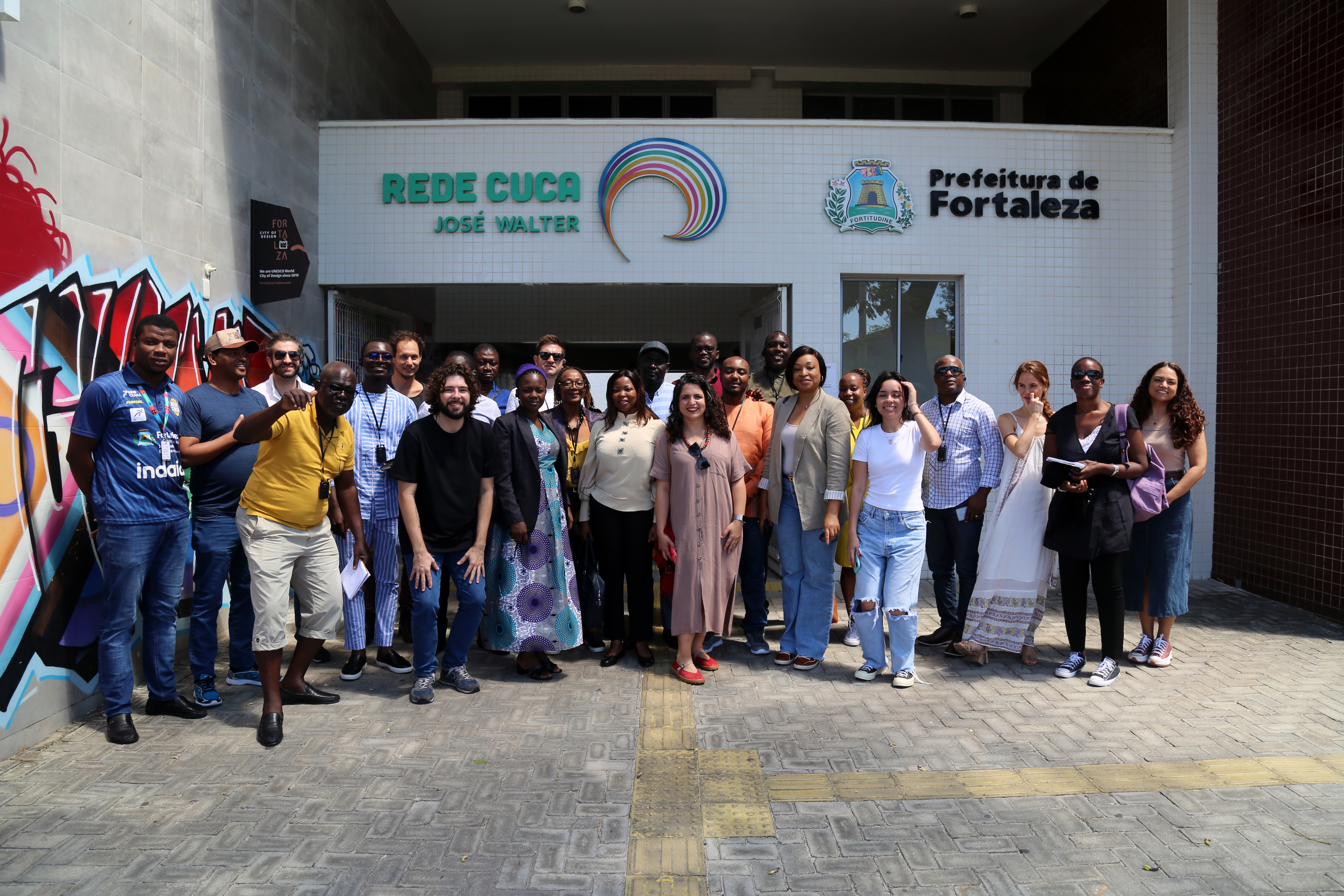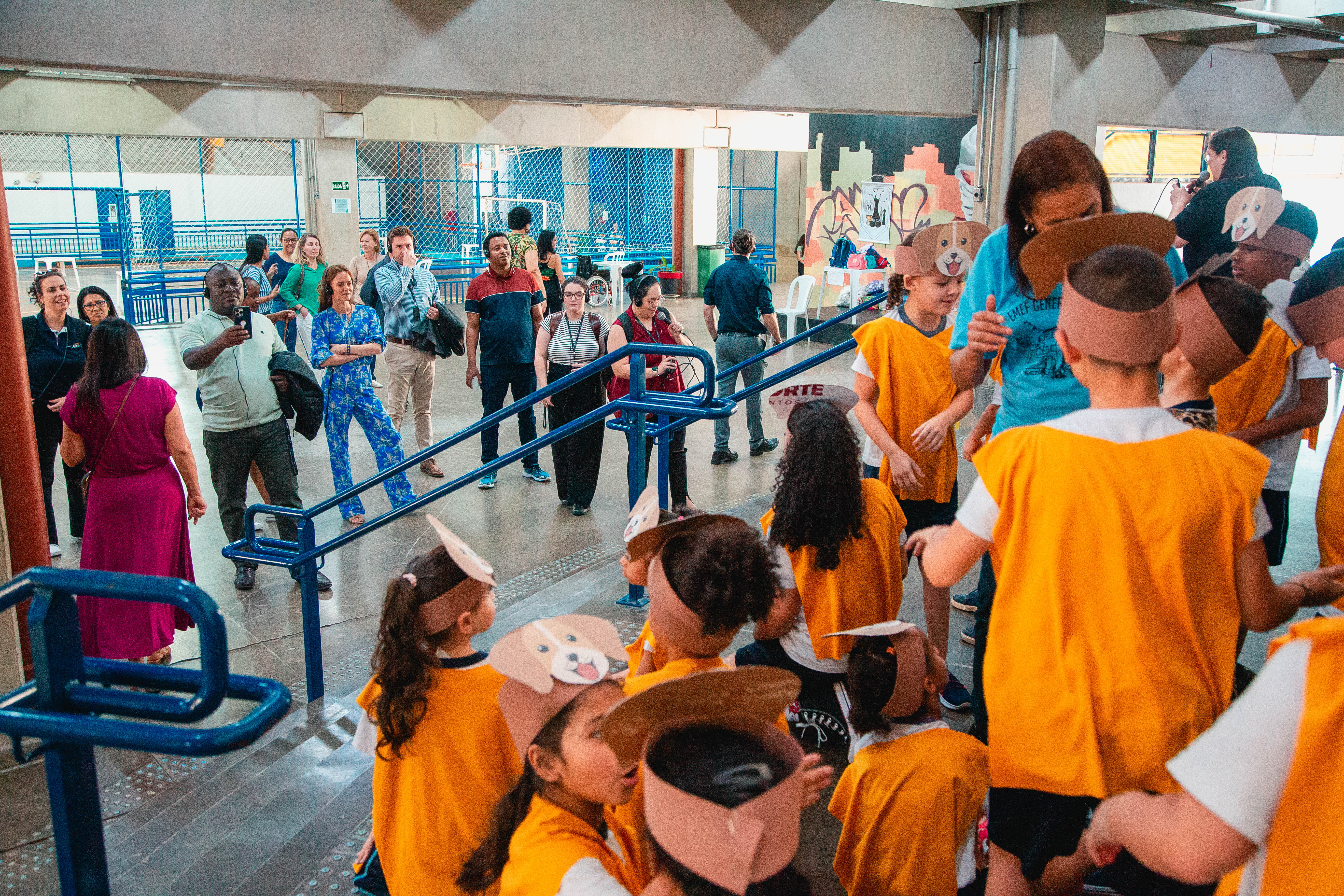Publicly Run Multipurpose Facilities: How Targeted Investments Can Drive Broad Environmental, Social, and Economic Change
Investing in youth and in structural and recreational infrastructure can generate far-reaching benefits that go well beyond leisure. Participants in the Brazil Study Tour witnessed firsthand how investments in violence prevention, economic opportunity creation, and health improvements can transform communities and support broader social progress.
Learn more about the Brazil Study Tour 2024 organized as part of the African Cities Program (ACP) here.
The CEU in São Paulo and the CUCA in Fortaleza serve as powerful examples of how targeted investments in facilities, originally designed to serve specific populations, can become catalysts for urban policies with wide-ranging positive effects on the environment, poverty alleviation, education, and employment.
Although primarily designed to support young people aged 15 to 29 from high-vulnerability areas, these facilities are accessible to the broader public, making them hubs of community integration and social inclusion.
The CUCA case study: Investing in urban centers to promote youth inclusion, fight violence and poverty

In Fortaleza, the delegation visited one of the CUCAs (Urban Centers for Culture, Art, Science, and Sport), a multimodal center located in the extreme south of the city, in an area known as the poverty belt. This region is characterized by low Human Development Index (HDI) scores and high levels of violence.
As director Caiubu Mina explained, the CUCAs form a network of centers spread throughout the municipality, particularly in outlying districts, with a primary focus on social inclusion. Fortaleza invests nearly $10 million a year in its youth programs, surpassing the spending of Rio de Janeiro and even the federal government.
The facility is enormous, constructed in two years at a cost of 50 million reais. It welcomes between 6,000 and 10,000 visitors each month, providing young people with opportunities to develop technical, artistic, and intellectual skills. The center includes a theater, sports halls, a coworking space, an audiovisual room, and a film club. While visitors can take classes, they can also utilize the facilities for themed activities; for instance, the delegation encountered a group of dancers rehearsing during their visit. This interaction allowed for a dialogue to better understand their expectations and offer support in developing their activities.
The cinema is also integral to this inclusion policy: the free cine-club allows young people from underserved areas to watch films that would otherwise be inaccessible due to high ticket prices at shopping mall cinemas.
Culture, Technology, Human Rights, and the Environment: CUCA Creates Opportunities for Local Youth and Positively Impacts the Community
"If the CUCA didn't exist, if this facility didn’t exist, what would the young people in the neighborhood be doing?" asks Caiubu Mina, the center's director.
The CUCA has two primary components: the first focuses on culture, contributing to artistic training through courses and providing performance spaces and cinemas for cultural dissemination. The second component emphasizes sports and technology, offering 24 different sporting activities that prioritize education over purely athletic performance.
Additionally, there are support programs for learning technology, communication, and information, with courses in computing, photography, programming, and visual editing. Notably, these courses have a practical, job-oriented dimension. Caiubu Mina informed the delegation that 30% of students who complete their practical courses successfully enter the job market.

Finally, the CUCA incorporates a third component focused on human rights, health, and the environment. The center provides psychological and social support through social workers and psychologists for the community. This initial dialogue is instrumental in identifying problems and referring young people to specialized services. In terms of health, the center is developing a preventive policy that aligns with the municipality’s proactive approach to risk reduction, ensuring that no one feels excluded through a non-judgmental lens.
For environmental initiatives, CUCA supervises groups of young volunteers who actively engage in community efforts to collect trash and raise awareness, such as preventing sites from becoming open-air dumps. The CUCA thus serves as a space for promoting and disseminating opportunities within the community, acting as a public resource for engaging with residents without solely relying on a security perspective. It operates as a zone of peace: situated in an area with a strong gang presence, the facilities are respected by all stakeholders, including those involved in illegal activities.
Additionally, CUCA awards scholarships to empower young community members to work with specific target groups, including training some as environmental mediators. These grants, which cover around fifteen different themes, help young people become recognized and professional advocates. Engaging peers to spread awareness reinforces the effectiveness of these initiatives.
The respect the center commands from the neighborhood and its youth further attests to its value. Its neutral stance allows CUCA to transcend community conflicts, and it has become such a refuge that, during episodes of violence in the area, people often seek safety within its walls. Notably, the municipality—particularly the Institute for Urban Research and Planning and the Youth Secretariat—consistently collects data on violence to inform and enhance the work of the federal government.
Gaining Agility and Efficiency Through Public Service Delegation
CUCA operates as a private, not-for-profit association, fully funded by the municipality, which assigns it a public service mission to enhance efficiency and flexibility. While municipal administration often faces cumbersome bureaucratic processes for recruitment and contracting, CUCA can navigate these challenges with greater agility and effectiveness in utilizing public resources.
It is crucial to measure results in terms of attendance and user satisfaction. Detailed surveys are conducted to gather information on the demographics of the young people who frequent the center, including their socio-economic and racial profiles, as well as community perceptions of CUCA, along with evaluations from the users themselves.
For the final leg of the tour, participants visited the center's coworking area, which is frequented by small entrepreneurs seeking support, coaching, and advice to help structure their businesses. The coworking space has also evolved into a hub for exchanges and coaching courses. Currently, they are collaborating with a supermarket set to open in the area, assisting with community outreach and conducting pre-interviews to prepare residents for job applications and interviews, thereby playing a vital role in integrating individuals into the job market.
The CEU Case Study: Leveraging an Education Center to Drive Synergies and Generate Cross-Cutting Benefits for Education, Employment, and the Environment.

In São Paulo, participants visited the Centro Educacional Unificado (CEU) Parque Bristol, a center dedicated entirely to the residents of surrounding working-class neighborhoods. The CEU aims to provide comprehensive, democratic, emancipatory, and humanizing education with a focus on social quality, integrating education, culture, sport, and leisure.
The center operates every day of the week—including Sundays, holidays, and vacations—until 11 p.m. on weekdays, ensuring accessibility year-round. As one of the speakers noted, “It is possible to attend the center from your first days to your last.” Visitors can engage in a wide range of activities, including sports, dance, and music.
On average, over 2,000 students attend the center daily, as Brazilian students typically attend school in either morning or afternoon shifts. The CEU provides a safe alternative for children, helping to prevent them from spending their days on the streets amid the community’s poverty. Students also benefit from the School Feeding Program, and an ecological vegetable garden serves as an educational tool to raise awareness about nutrition and environmental sustainability. The daycare services offered are particularly beneficial for families, especially single mothers, allowing them to work and pursue their careers while their children are cared for.

The center offers services free of charge for children and is funded by the municipality, which places a strong emphasis on education. Importantly, these initiatives draw from multiple departmental budgets, not just education; they also involve sports, social development, crafts, and employment. By collaborating across various secretariats, these programs create synergies that maximize resources. This integrated approach leads to long-term benefits across the value chain, positively impacting employment, the environment, and education.
During our visit, we also had the opportunity to see one of the center's community training programs. The center features a kitchen that hosts cooking workshops open to all residents. Registration for these workshops operates on a first-come, first-served basis, allowing anyone in the community to participate.
An awarded program in schools to promote health and sustainability: The School Feeding Program

The CEU is part of the National School Feeding Program, recognized as the largest and most comprehensive initiative in Public Food and Nutrition Policies in South America. It is also one of the largest and oldest programs globally, distinguished by its free and universal provision of meals. Awarded by C40, it is considered one of the most successful and replicable programs in the world. The CODAE (School Feeding Coordination) manages the technical, administrative, and financial aspects of the school feeding program in São Paulo, serving 2.5 million meals a day to 1 million registered students across 4,000 educational units.
The program fosters food security and sustainability in schools by providing nutritious, varied, and safe meals to all children enrolled in the Public Education Service, contributing to Food and Nutritional Security (FNS) policy. A key sustainable component of the program involves sourcing locally produced goods from family farms and local communities. By offering free meals, the authorities encourage families to send their children to school and help combat obesity and diseases linked to malnutrition. Above all, this program creates a virtuous economic cycle.
These centers have a significant impact on many lives across various dimensions, highlighting the enormous potential for similar initiatives in African cities. As demonstrated by the examples of Fortaleza and São Paulo, local cultural infrastructures can serve as vital points of contact and interaction with communities, facilitating the implementation of effective policies that benefit society as a whole. The Brazil Study Tour organized by the UMDF was designed to do just that: encourage African cities to draw inspiration from Latin American experiences to improve the lives of their populations.
Learn more about the key lessons that African cities can learn from Latin American experiences by reading this report: launched in october 2023, it details recommendations and policy insights to change the life of the population living in informal settlements.

